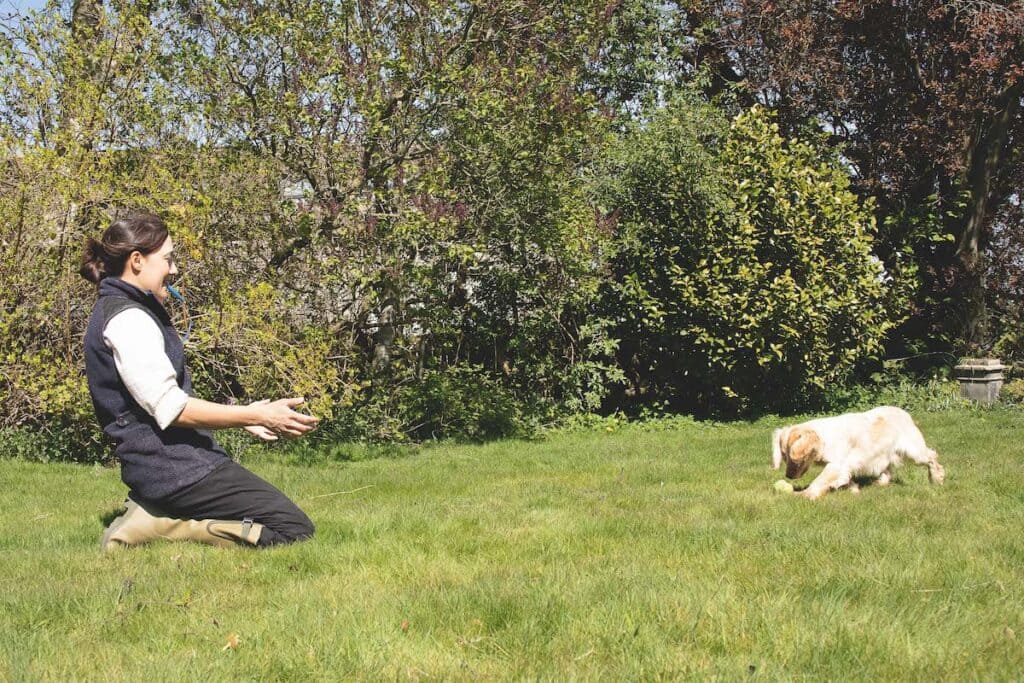Table of Contents
A puppy or dog, if well-behaved, is such a wonderful companion to be around. You can either enroll your dog in a board-and-train program or teach them the basic commands at home with ease. You just need to be a little familiar with your dog’s nature, and you can easily teach them the basic manners. If you want to bring out the best in your little furry friend, teach them the basic dog commands. This article guide will entail the basic commands that you need to teach your dog for them to be a well-mannered puppy. So, without further ado, let’s get into the guide.

Understanding the Importance of Training and Dog Commands
It’s like finding a treasure trove of unending partnerships and fun when you train your dog. The process of dog training is important and rewarding, from learning basic dog training commands to teaching your dog hand signals. Since dogs learn by repetition and positive reinforcement, training is an essential part of their development and well-being. Additionally, dog training improves communication and strengthens your relationship with your pet. It also encourages excellent behavior, making your dog a pleasure to be around in any situation. It pays off much to devote time and effort to dog training, whether the goal is more advanced skills like sit or stay. So, gather up your favorite treats, get ready for some exciting tail-wagging, and set out on an adventure of growth and learning with your furry friend.

15 Basic Dog Commands to Master
Now, this section of the article will cover 15 common dog commands that if you know them, you can teach your furry fellow.

1. Sit Command: Basic Dog Commands
Start the training session by teaching your dog the sit command. Lower their hindquarters gently while using hand signals and verbal commands. Start by using specific commands for dogs and raising your hand with your palm facing upward to teach your dog the sit command. Adjust according to your body posture if you are left-handed. However, to successfully reinforce the desired behavior during the training process, make sure you are patient and consistent.

2. Stay Command: Important Dog Commands for Controlled Behavior
Extend your hand, palm facing your dog, and offer the verbal command to stay. Make sure your body language is clear to back up the instructions. This is an easy dog command that uses hand signals. If you want to teach the stay command, start your dog in a sit or down position so that you may teach him the “stay” command. Say “stay” in a calm yet forceful voice while holding out your hand with the palm facing them. Reward them for staying put. After that, take a small step back and then return. Dogs can be trained to stay by using hand commands. Additionally, as your dog gets better at following your dog’s commands, progressively increase the distance and length.

3. Down Command
Encourage your dog to lie down by giving them the down command and using your verbal cues to help them along. Use dog hand gestures to begin teaching your dog the down command. To begin, sit down, then raise your hand and make a circular motion toward the ground while you say “down.” If your dog follows the motion, give them a treat. Maintaining consistency is important.

4. Come Command: Make your Furry fellow Obedient Using Dog Commands
Use the verbal command “come” along with hand signals to tempt your dog to approach you. Teaching your dog using hand signals just like this will help the dog to understand faster. Dogs learn the “Come command” through body language and verbal cues. Begin in an area with minimal distractions. Call your dog’s name and say “come” in a cheerful voice. Offer them your arms wide open and your positive vibes. Give them lots of praise when they approach you. Practice in different environments with progressively more distractions. Additionally, for trustworthy recall, repeat the instruction on a regular basis.

5. Heel Command for Dogs
Take your dog on a walk with a leash on. Remind them of the “heel command” by using your hand to direct their steps and observe proper leash behavior. Start with your hand by your side, palm facing your body, and teach your dog the heel command. Make use of verbal cues and indicate your preferred walking position by pointing your finger. Give your dog praise and a reward when they correctly walk beside you. Besides, practice in various settings and repeat regularly, progressively increasing the length as reinforcement.

6. Leave It: Easy Dog Commands
Give your dog the command to “leave it” and use hand signals to grab their attention to stop them from playing with unwanted objects. The first step in teaching your dog to “leave it” is by providing them with an appealing toy. Say “Leave it” in a stern voice and make the stop-hand motion. Give them praise and rewards when they stop. Increase difficulty gradually. Additionally, practice consistently and give positive rewards to reinforce. By using dog command hand signals, you can improve communication between you and your dog while also helping them grasp the command.

7. Drop It Command
Give your dog the “drop it command” to take anything out of their mouth, and use hand signals to help them remember to do it.
This is how you can teach your dogs one of the basic dog commands:
1. Select a Quiet Environment: Make sure your training space is free of distractions.
2. Select Your Dog’s Favorite Toy: Begin with a toy that your dog likes and isn’t really attached to.
3. Start Playtime: Play with your dog and allow him to take the toy.
4. Offer a gift: To get their attention, present them with an expensive gift.
5. Say the Command: Say “Drop It” again in a forceful, clear voice.
6. Encourage Release: To get them to drop, gently hold the goodie up to their nose.
7. Reward and Praise: As soon as they drop the toy, give them a treat as well as instant praise.
8. Repeat and Practice: Practice several times a session, progressively stepping up the level of difficulty.
9. Use Real-Life Scenarios: Apply the command to regular circumstances in which your dog retrieves objects.
10. Be Patient and Persistent: Celebrate your accomplishments, and don’t give up; consistency and patience are essential.

8. Fetch Command
Using the command “fetch,” you can train your dog to find objects. You can also guide them with hand signals to help them return the object to you. If you want to teach this basic command to your puppy, start by using verbal and hand signals to get your dog to pick up a toy or object. Give them lots of praise to encourage them to bring it back to you. If your dog doesn’t come readily to retrieve, use the command to gently cue them along and give them treats as they go. Continue, progressively extending the distance. But, if your dog becomes disinterested, change the game’s intensity or try again at a later time. This enjoyable and practical command will become deeper-rooted with regular practice and encouragement. 
9. Wait Command: Helping Your Furry Friend with Patient Dog Commands
Hand signals and the “wait command” can be used to tell your dog to halt or postpone their actions. This command instills patience in your furry friend. Let’s give your pet a playful spin on learning the wait command. Imagine that your dog is excited to chase after a ball when you are at the park. The “wait command” works wonders when you toss it because it pauses at your cue rather than bolting off. As you raise your hand and face them with your palm facing, begin using simple commands for dogs, such as “wait.” Give them a treat as a reward for their patience, then progressively extend it. However, keep in mind that developing consistency is crucial to grasping this essential skill.

10. Off Command
Use the “off command” to stop your dog from jumping, and use hand signals to help them step down or lower their body. You got it! It might be quite easy to teach your pet to respond to an off-command. Begin by softly urging them to leap up, and then say “off” in a forceful yet kind manner. Use hand signals and clear body language to help them lower their body. As soon as they cooperate, give them something. However, the most important thing is to be consistent; practice often and repeat the command in many contexts. Your dog will eventually learn that being “off” implies keeping all four paws on the ground, which will improve everyone’s ability to interact. 
11. Quiet Command
Use the “quiet command” to stop excessive barking, and encourage it with hand signals to remain silent. Well, have you ever wished for a little calm amid your dog’s loud barking? Gaining mastery of the quiet command can be your key to peace. After a short time of silence, calmly say quiet and place a goodie close to your dog’s nose. Give them praise and the treat when they stop barking to smell it. Continue in this manner, progressively lengthening the interval between rewards. However, consistency is essential, so reinforce the quiet command with patience and persistence.

12. Go to Bed: Comfortable Dog Commands
When giving your dog the “go to bed command,” use hand signals to lead them to the appropriate spot. Do you have a restless dog that requires a special place to unwind? It’s time to give the order to “Go to bed.” Choose a comfortable location for your pet’s bed first. Treats and praise can be used to reinforce the behavior as you lead them to the bed using dog commands and commands for dogs. But exercise patience. It can take some time for your dog to understand. Practice frequently until they understand the instruction and happily come home in their comfortable area.

13. Shake Command
Hold out your hand, give your dog the “shake command,” and use hand movements to get him to shake paws with you. Let’s shake things up by giving your dog the Shake Command. This entertaining move is a paw-some addition to the list of dog basic commands. Start by holding a goodie in your palm to pique your pet’s interest. Say “shake” and slowly lift their paw as they smell and paw at your hand. Give them lots of praise for moving their paws at all. Additionally, continue the process while progressively lengthening the time they keep their paw raised. Your dog will soon start shaking on command.

14. Roll Over Command
When teaching your dog the “rollover command,” use hand signals and rewards to help your dog learn to roll over onto their back. Do you want to give your dog’s trick kit a little more flair? A fun and amazing success is learning the Rollover command. Get your dog to lie down as a starting point. Move a reward in a circular motion while holding it close to their nose to get them to follow with their head. Give them a treat and give them lots of praise when they roll onto their back. Proceed once more, using hand signals to train your dog and basic commands such as “down” and “roll over.” Furthermore, your dog will soon be rolling like a pro if you are persistent.

15. Speak Command: Dog Commands to Learn
This command, which is particularly helpful for training a deaf dog, teaches your dog to bark on cue by using hand signals to trigger vocalization. Are you prepared to give your dog’s voice some style? The Speak Command is very easy to teach. Start with your hand and extend it in the direction of your dog, especially if you’re left-handed. Say “speak” with a positive attitude. Give them lots of praise if they make any noise at all, even a small woof. Repeat this procedure using sweets as an incentive in addition to your hand. Your pet will soon be barking on cue, surprising everyone with their newly acquired ability if you continue regularly.
However, if you want to learn more about the basic dog commands, check out this blog.

Difference between Military/ Police and Common Dog Commands
Commands given to police and military dogs frequently center on obedience, accuracy, and specific duties like bomb detection or apprehending. They contain intricate directives such as “attack” or “search.” However, common dog commands like “sit,” “stay,” and “come” place more emphasis on good manners and basic obedience. Good behavior and communication between pet owners and their animals are encouraged by these commands. Basic obedience training can be helpful for all dogs, but military and police dogs need specific training designed for their tasks, with an emphasis on responsiveness and discipline under duress.
Conclusion
To sum up, this article covered basic dog commands that you teach your furry friend at home. It is an easy solution for teaching good manners to your companion. You can either enroll them in a professional training program or teach them easily at home. Moreover, the differences between the military dog command, police dog commands, and basic commands are mentioned. So, bring out the best in your furry partner.
Sit, Stay, Sparkle!

